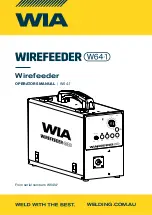
11
Safety Precautions
2
Warnings & Cautions
Turn Off Power!
Before servicing, make sure you have turned off
compressed air and electrical power in a way which prevents
accidental reactivation. Padlock and clearly tag the appropriate
electrical and pneumatic disconnects. Lockout/tagout procedures
are covered in United States Code of Federal Regulation (CFR)
Title 29 Part 1910.147, “The Control of Hazardous Energy.”
Dress Appropriately!
Reduce the risk of injury from moving parts
by securing loose sleeves and other clothing. Don’t wear loose
jewelry or neckties near the feeder. Wear safety glasses or other
protective eyewear when servicing the feeder. Never place hands
or tools in the feeder when it is operating.
Install Safety Covers!
Make sure the feeder remains safe to operate.
Be sure all safety covers have all been installed before returning the
feeder to normal operation. Safety covers on the FR-20 and FR-30
feeders include any covers installed by your direct supplier, as
well as the exit area cover (which protects the operator from
moving sprockets and belts.)
Operating & Maintenance: Do's & Don'ts
DonÕt Give the Feeder Too Much Product.
Don’t overload the
feeder, or it may jam or lose rate. Product must be carefully
metered into the feeder from bulk. Allow only enough product
into the feeder to keep the line running at the required rate.
DonÕt Run the Feeder Too Fast.
Don’t run the bowl faster than the
linear feet per minute recommended by your direct supplier. If you
do, the orientation qualifiers cannot function as efficiently, and the
feeder may jam or lose rate.



























